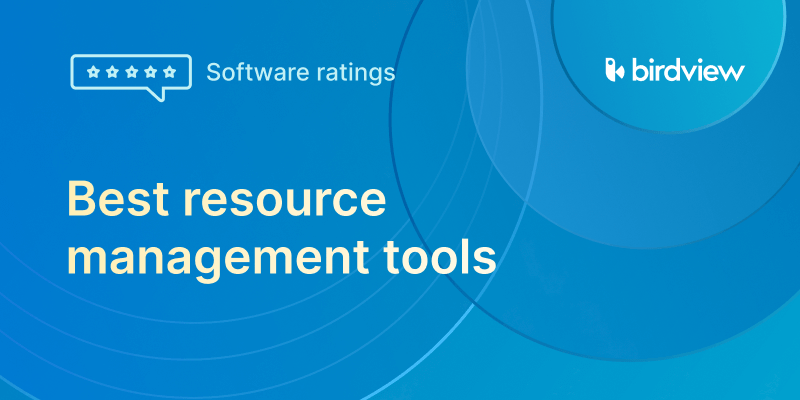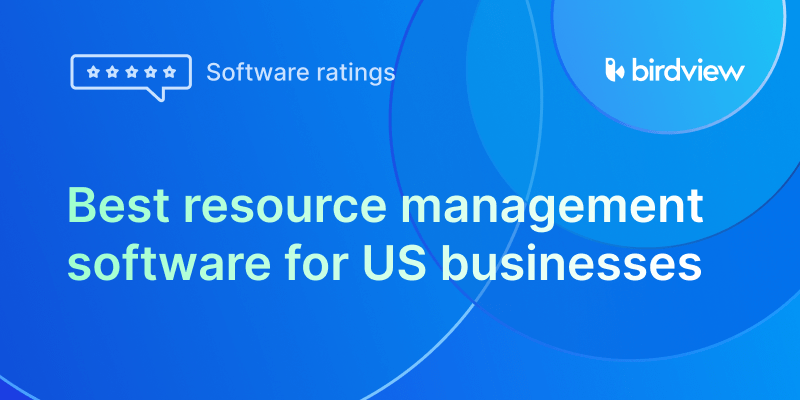Are you aiming to achieve your organization’s goals while maintaining a healthy work environment? This guide delves into the significance of workload planning and offers actionable advice on implementing it effectively within your organization. It is tailored for managers, team leaders, or anyone looking to optimize their personal or team workload.
Why workload planning is important
Have you ever wondered why some teams excel in delivering projects on time while others struggle with delays and burnout? The answer often lies in how they manage their workloads.
Workload planning involves distributing tasks and responsibilities evenly among team members.
Workload planning implementation helps you:
- Assessing workloads: Start by evaluating the current workload of each team member. How are tasks currently being managed, and where is the pressure most intense?
- Prioritizing tasks: What are the high-priority tasks that will drive your project forward? Identify these to ensure focus where it’s most needed.
- Allocating resources wisely: Are resources being utilized to their fullest potential? Allocating the right resources to the right tasks can prevent overburdening and underutilization.
- Setting realistic deadlines: How often are project timelines met? Setting achievable deadlines is key to maintaining team morale and productivity.
Workload planning is more than just good practice; it’s a necessity for preventing task overload and ensuring an efficient flow of operations. By investing time in a structured approach to workload planning, you lay the groundwork for a more organized, productive, and motivated team.
Implementing these strategies effectively requires a commitment to regular review and adjustment of workloads, ensuring that your team not only survives but thrives. Are you ready to take your team’s productivity and job satisfaction to the next level? Let’s embark on this journey of strategic workload management together.
Read more:
What goes wrong when you skip out on workload planning
Are you aware of the potential pitfalls that poor workload planning can bring to your team and projects? Many organizations overlook the critical role of effective workload distribution, only to face significant operational and personnel issues later on. It‘s crucial to recognize these challenges early to prevent them from escalating and negatively impacting your organization‘s success.
Here’s what could go wrong when tasks are not distributed evenly:
Overworked and underutilized team members
An uneven task distribution can lead to some team members feeling overwhelmed, triggering stress and burnout. At the same time, others may become disengaged due to a lack of sufficient work.
Missed deadlines and project delays
Without a coherent strategy, tasks may be overlooked, resulting in missed deadlines and project delays that could have been avoided with better planning.
Decreased productivity and motivation
A lack of structured planning often leads to reduced productivity and dwindling motivation, as team members struggle with inefficient task management.
Higher turnover rates
The stress and dissatisfaction from inadequate planning can lead to increased turnover rates, which disrupt team dynamics and drive up the costs associated with recruiting and training replacements.
Lower quality of work
Employees who are overburdened may rush their tasks, leading to mistakes and a reduction in work quality. Simultaneously, underutilized employees may underperform due to their disengagement.
Inefficient use of resources
Poor planning can result in the wasteful use of time, skills, and tools, escalating costs unnecessarily.
Client dissatisfaction
Issues such as missed deadlines, poor work quality, and delays can lead to dissatisfied clients, potentially damaging relationships and leading to a loss of business.
Inability to scale and grow
Inadequate workload planning can hinder the ability to scale operations or take on new projects, as the team is bogged down managing current workloads without significant disruptions.
How to kickstart efficient workload planning
Are you getting the most out of your team’s efforts? Consider this: effective workload planning isn’t just about ticking boxes; it’s about ensuring tasks are allocated fairly and resources are used wisely. How can you streamline this process and set your team up for real success?
1. Assess current workloads
Understanding the existing workload distribution helps identify areas where team members may be overburdened or underutilized.
- Start by gathering data on your team’s current tasks and responsibilities.
- Use tools and software to track workloads accurately.
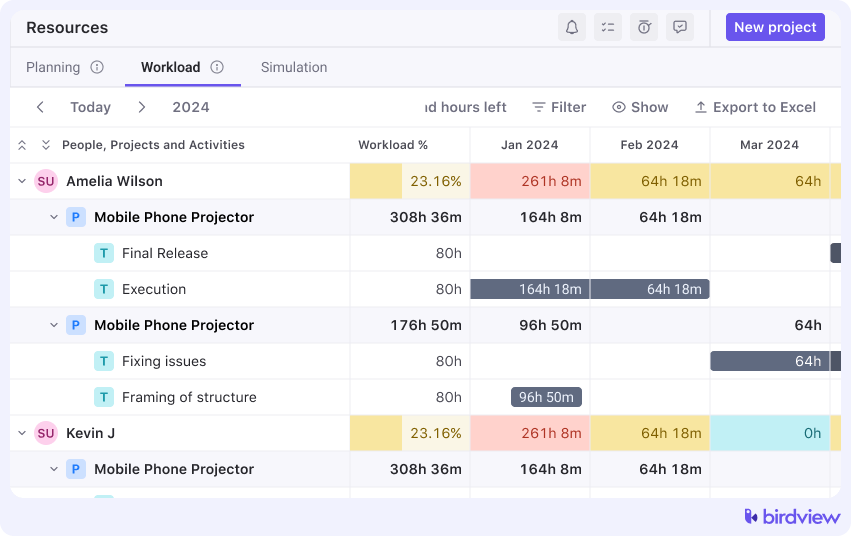
2. Prioritize tasks
Prioritizing tasks helps to optimize resource utilization and ensure that critical work is completed first, reducing the risk of missing important deadlines.
- Identify high-priority tasks and deadlines.
- Focus on the tasks that have the most significant impact on your project or goals.
3. Allocate resources wisely
- Match tasks with team members’ skills and expertise.
- Ensure everyone has a balanced workload that suits their abilities.
Consider factors such as each team member‘s strengths, experience, and current workload to make informed decisions about task assignments.
4. Set realistic deadlines
Realistic deadlines help manage expectations and reduce stress, ensuring that tasks are completed without compromising quality. It also helps to finish projects on time, thus keeping your customers satisfied.
- Avoid over-committing by setting attainable goals.
- Always factor in buffer time for unexpected issues.
5. Monitor and adjust regularly
Regular monitoring allows you to identify potential bottlenecks early and make adjustments to prevent delays and overwork.
- Continuously track progress and workloads with business intelligence reports.
- Be flexible and ready to adjust plans as needed to keep everything on track.
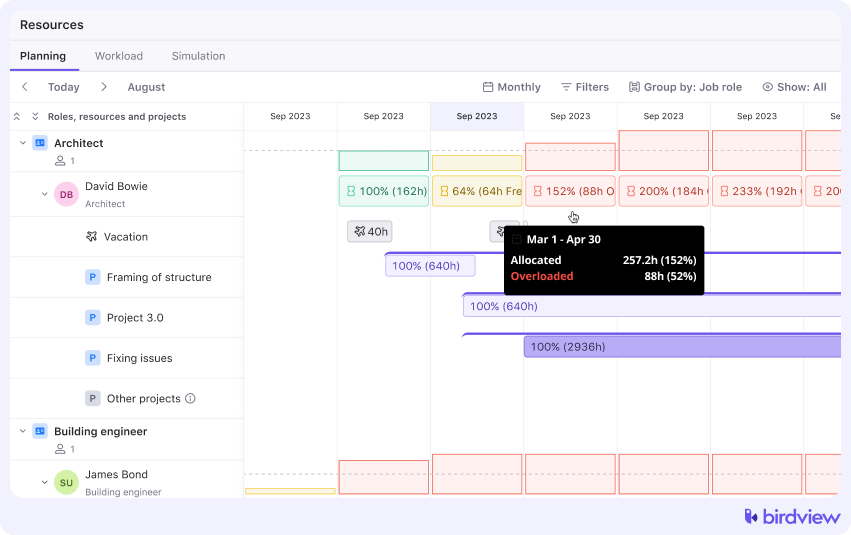
6. Use workload planning tools
- Implement software and tools that streamline the workload planning process.
- Ensure everyone has access to the necessary resources and information.
How PM tools help with workload planning
Project and resource management tools, such as Birdview, offer a comprehensive suite of features designed to streamline the workload planning process, making it easier for teams to stay organized, productive, and on track.
With such solutions, you can ensure that your team‘s tasks are well-managed and resources are optimally utilized, leading to better project outcomes and enhanced team satisfaction.
Read more:
These are the key features you need to look for in a project management platform to help you take your workload planning to the next level:
- Resource planning
Birdview’s resource planning feature helps you manage and allocate team members. This feature provides a comprehensive overview of resource availability and utilization, allowing you to plan projects more accurately and avoid overcommitting resources. Effective resource planning ensures that you have the right resources available when needed, reducing delays and enhancing project efficiency.
- Real-time workload tracking and reporting
Birdview allows you to monitor workloads in real time, giving you a clear picture of how tasks are distributed among team members. This feature helps you quickly identify who is overburdened and who might have the capacity for additional tasks.
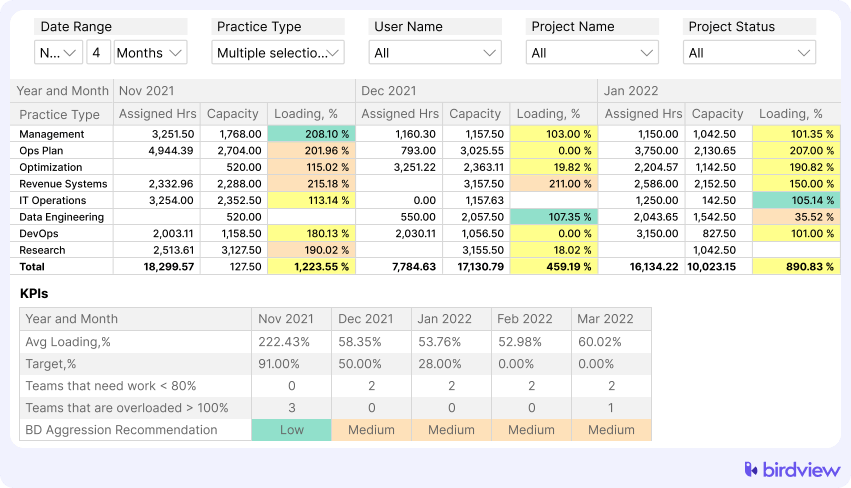
- Smart resource selection
Birdview’s AI Assistant helps you assemble a team that aligns perfectly with project requirements. You can choose the best-fitting candidates by job roles, skill sets, availability, and hourly rates. This feature allows you to book the resources needed for your project in advance, ensuring you have the optimal team in place to deliver successful project outcomes.
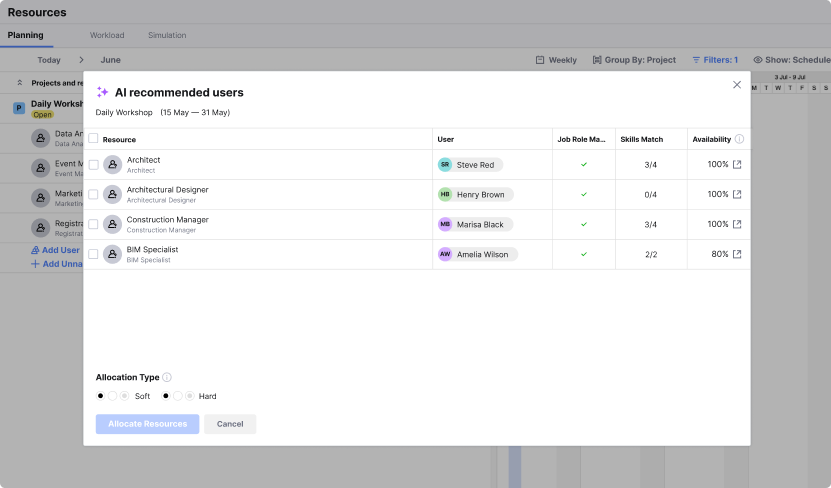
- User-friendly interface
Birdview‘s intuitive interface makes it easy for everyone on your team to use. The platform is designed to be accessible, with features that are straightforward to navigate. This ease of use reduces the learning curve and ensures that your team can quickly adopt the tool and start benefiting from its features. The interface also promotes better collaboration by allowing team members to view and update their tasks effortlessly.
Getting started with Birdview
While you have decided to implement a workload planning solution to significantly enhance efficiency and transparency in managing tasks and resources, here’s how to make your first attempt with Birdview to explore its powerful resource management capabilities fully.
1. Explore the features
Familiarize yourself with Birdview’s capabilities such as real-time tracking and resource allocation, capacity planning, etc. Understanding these features fully can help you leverage the tool effectively.
2. Sign up for a free trial
Most tools offer a free trial period, and Birdview is no exception. Use this period to explore how Birdview fits into your existing workflow.
3. Schedule a demo
If you’re interested in seeing how Birdview works before signing up, scheduling a demo can be a great way to get a comprehensive overview of its functionality and ask any specific questions you might have.
4. Customize your setup
Once you decide to use Birdview, customize your dashboard and settings according to your team’s needs. This might include setting up project templates, defining task categories, or integrating other tools.
5. Roll out gradually
Start by introducing Birdview to a small project or team. This allows you to manage the learning curve and make adjustments before rolling it out to the entire organization.
By taking these steps, you can begin to integrate Birdview into your workload planning process, making task management more streamlined and transparent for your team.

